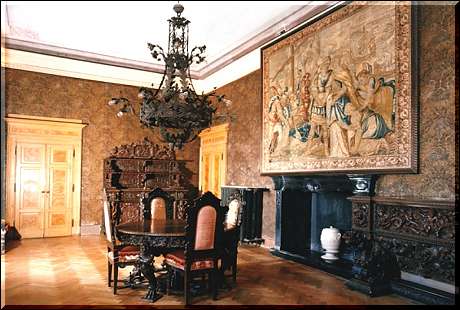 La sala presenta gli arredi originari voluti dal tedesco W.E.J. Kees (1864-1906), che acquistò la villa nel 1897 e la decorò con il proprio gusto eclettico.
La sala presenta gli arredi originari voluti dal tedesco W.E.J. Kees (1864-1906), che acquistò la villa nel 1897 e la decorò con il proprio gusto eclettico.
Dopo averla ristrutturata, il proprietario la dotò dei confort del nuovo secolo come l’impianto di riscaldamento centralizzato, tutt’ora funzionante e di cui se ne conservano i bellissimi termosifoni. Secondo quanto indicato dai manuali di arredo ottocenteschi, Kees scelse lo stile neorinascimentale adatto per una sala da pranzo. Infatti ha utilizzato gli straordinari mobili realizzati nei famosi laboratori di Michelangelo Guggeneheim con sede a Palazzo Balbi sul Canal Grande a Venezia, nei quali la borghesia e l’aristocrazia europea si riforniva di arredi .
La tappezzeria con finissime lumeggiature dorate e putti alati riprende i decori presenti nell’imponente specchiera.
Una sala di forte impatto all’interno della villa, che contrasta i tipici colori del lago su cui si affaccia.
The room has the original furnishings wanted by German W.E.J. Kees (1864-1906), who bought the villa in 1897 and decorated it with his eclectic taste.
After it is restored, the owner of the endowed the new century comforts like central heating system, still working and which are preserved the beautiful radiators. As indicated by the nineteenth-century furniture manuals, Kees chose the neo-Renaissance style suitable for a dining room. In fact, it has used mobile overtime made in the famous workshops of Michelangelo Guggeneheim based in Palazzo Balbi on the Grand Canal in Venice, in which the bourgeoisie and the aristocracy of Europe was supplied with furniture.
Upholstery with fine golden winged putti and resumes highlighting the patterns present in the imposing mirror.
A strong impact hall inside the villa, which contrasts the typical colors of the lake overlooked.

